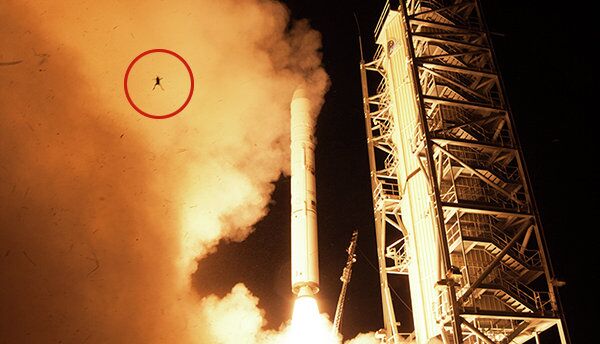WASHINGTON, September 12 (RIA Novosti) – It’s hard to tell what frogs are thinking, if they’re thinking at all.
So it remained a mystery on Thursday if a four-legged amphibian was jumping for joy or living through every toad’s worst nightmare when he photobombed a shot of a NASA spacecraft launching toward the moon last Friday.
But there he was, reveling in his 15 seconds of fame, spread-eagle and high off the ground, his face lifted toward the heavens and his tiny silhouette illuminated by the orange glow of flames from a rocket carrying NASA’s Lunar Atmosphere and Dust Environment Explorer (LADEE) payload on a mission to the moon and then into lunar orbit.
“It's an authentic photo,” Keith Koehler, news chief at NASA’s Wallops Flight Facility in Virginia, told RIA Novosti in an emailed comment on Thursday, “taken by a still camera on a sound trigger set-up” during the 11:27 p.m. EDT (0330 GMT) launch Sept. 6.
“There were about 8 or 9 frames in the sequence. However, this is the only one showing the image of a frog,” he added.
It was, to borrow a phrase from astronaut Neil Armstrong when he took the first step on the Moon in 1969, “one giant leap,” but this one wasn’t for mankind, it was for “frogkind.”
NASA’s Chris Perry, who is credited with taking the photo, told RIA Novosti by email that the frog was about 150 feet (46 meters) from the rocket.
“It's worth noting for us at Wallops because we've never caught anything like this,” Perry said, adding, “Our photo archive contains launch sequence photos from every launch, and none that I've seen so far has shown us anything like this before.”
He also ventured a guess as to what was likely the ill-fated creature’s final meal: “Lots of flies out there that evening, so I'm sure our frog or toad had a nice feast that evening.”
Frogs sleep by day and look for food – and love – by night, and the biggest ones found in North America are bullfrogs, with bodies that grow up to eight inches (20 cm), according to Discovery’s Animal Planet.
LADEE is on a robotic mission that will orbit the moon to gather detailed information about the lunar atmosphere, conditions near the surface and environmental influences on lunar dust.
“LADEE is doing well right now, but we are not certain of the frog's fate,” Koehler reported.
It was “definitely a surprise to us, and a little sad,” Perry said.


